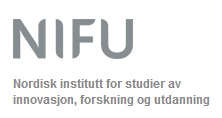Nordic Crossing
Nordic Crossing is one of two complementary projects recently commissioned by NordForsk to study “Mobility of Researchers and Knowledge Transfer in the Nordic Region – Patterns, Framework Conditions, Incentives and Trends”. The projects started at the beginning of the year and runs through August.
Researcher Mobility and a Nordic Perspective
Improving the conditions for researcher mobility is (re)emerging as a central priority of European research and innovation policy. This priority is prominent in the Europe 2020 strategy and in current policy initiatives under the European Research Area. These forward-looking objectives build on an extensive tradition in Europe for the study of researcher mobility patterns, the factors shape them and the effects they have. This tradition traces at least back to the Human Capital and Mobility program (1992) and it extends through to recent large-scale surveys.
The Nordic countries have been active contributors to this tradition. As small economies at the periphery of Europe, they have been keen to promote the benefits of researcher mobility both within the region and with other countries. In addition to size and geography, a set of other factors unite the Nordic countries around this common focus. Whatever or not there is a true ‘Nordic model’, there are certain commonalities in terms of academic traditions, cultural dimensions, labor-market organization, political organization, and international ties including a longstanding passport union. However, there are also important country-differences that affect mobility differently.
Thus, the launch of the twin Nordic studies emerges from within a longstanding tradition of Nordic work on researcher mobility. Nordic work pioneered the application of registry data to the study of researcher mobility in the 1990s (following the Canberra Manual, 1995), and, more recently, in the frame of the large-scale European surveys. The two Nordic projects follow up on this tradition. The Nordic Crossing project focuses on CV analysis across the Nordic region in light of the results of earlier European surveys we were involved in (MORE 1 and SIM ReC). In this sense, it follows up on the conclusion of the FP5 project. The ENMOB – European Network on Human mobility”(2001-2002), which grew from around researchers in the Nordic countries using registry data, concluded that CV analysis would in future be the promising way to study mobility.
In parallel with NIFU’s CV based study, Faugert (Sweden) is carrying out a large-scale interview-based study in the Nordic region. Its complementary goal is to better understand factors that affect research mobility in different contexts. The twin projects— together and separately— aim to provide an updated empirical basis on which to take stock of the current-status of researcher mobility with and between the Nordic countries. The goal is to draw implications about the extent, the effects and factors that shape researcher mobility.
SISOB and the way forward for the study of researcher mobility
The success of forward-looking initiatives in the Nordic region and in Europe more generally will continue to depend on reliable and up-to-date empirical work on changing researcher mobility patterns. The work of the SIBOB project is very promising for the future of research in this context. In order to address Horizon 2020 priorities on researcher mobility, better analytical tools and methods are needed. SISOB is building on existing European work to develop and adapt common tool-sets that are necessary to improving the empirical basis that the study of researcher mobility and its effects depends on. The Nordic Crossing project is very happy to be invited to participate in testing and evaluating the tools being developed by SISOB.
The Nordic Crossing project is still collecting CVs at this stage. We have gained access to anonymized data on job-changes and education for 900 researchers along the lines of the SICA data. Unfortunately, this data is limited to a single country. As in other studies, we have attempted to harvest CVs directly from the net. This is yielding a mixed bag of documents. At the same time, we are pursuing the strategy of targeting grant applications in line with work done in the UK (BBSRC) and elsewhere. We are currently working with a variety of institutions to gain access to relevant CVs. The approach yields better quality and more uniform documents. We have collected 400-500 CVs, mainly from Norway and Sweden, but this work is only now picking up steam.
Nordic Crossing is now midway in the project. We have just adapted a pilot set of CVs to the SISOB specifications, so we hope to try out in the coming days. We hope this will provide the SISOB team with feedback to help them continue improving on their approach. We very much look forward to following up on this in collaboration with the SISOB team.
Eric Iversen Research at the NIFU More information:Nordic Crossing es uno de los dos proyectos complementarios surgidos a petición de NordForsk con el objeto de llevar a cabo un estudio sobre “La Movilidad del Investigador y la Transferencia de Conocimento en la Región Nórdica-: Modelos, Condiciones Marco, Incentivos y Tendencias”. El proyecto comenzó a principios de año y finaliza en agosto.
Movilidad del Investigador y Perspectiva Nórdica
La mejora de las condiciones que fomentan la movilidad del investigador está convirtiéndose de nuevo en una prioridad fundamental en la política europea de investigación e innovación. Dicha prioridad es esencial en la estrategia Europea del 2020, así como en las actuales iniciativas políticas que se desarrollan en el Área de Investigación Europea. Estos objetivos orientados hacia el futuro se basan en una larga tradición llevada a cabo en Europa consistente en el estudio de los patrones de movilidad de los investigadores, los factores que lo conforman y los efectos que producen. Dicha tradición tiene su origen en el Programa de Capital Humano y Movilidad (1992) y se extiende hasta las más recientes encuestas a gran escala.
Los países nórdicos han contribuido activamente a esta tradición. Como pequeñas economías situadas en la periferia de Europa, han sabido promover los beneficios de la movilidad del investigador tanto en su propio territorio como hacia otros países. Además de su tamaño y geografía, otros factores unen a los países nórdicos en torno a este objetivo común. Exista o no un verdadero “modelo nórdico”, sí hay ciertos factores comunes en cuanto a tradiciones, dimensiones culturales, organización del mercado laboral, organización política así como lazos internacionales que incluyen una constante libre circulación de ciudadanos. Sin embargo, existen también diferencias significativas entre los países que afectan a la movilidad de forma diferente.
Así, la puesta en marcha del doble estudio nórdico surge dentro de una larga tradición sobre la movilidad del investigador. El trabajo llevado a cabo fue pionero en aplicar datos de registro al estudio de la movilidad del investigador en la década de los noventa (siguiendo el Manual de Canberra de 1995), y más recientemente, en el marco de las encuestas europeas a gran escala. El proyecto Nordic Crossing se centra en el análisis del CV de la región nórdica teniendo en cuenta los resultados de las primeras encuestas europeas en la que estábamos involucrados (MORE1 y SIM ReC). Del resultado se obtiene la conclusión que aparece en el proyecto FP5. EL ENMOB- Red Europea sobre Movilidad Humana” (2001-2002), que surge en torno a los investigadores de los países nórdicos usando los datos de registro, concluye que el análisis del CV se convertiría en el futuro en la vía más prometedora para el estudio de la movilidad.
Coincidiendo con el estudio basado el en CV de NIFU, Faugert (Suecia) está llevando a cabo en la región nórdica un estudio basado en la entrevista a gran escala. Su objetivo complementario es llegar a entender mejor los factores que afectan la movilidad investigadora en distintos contextos. Ambos proyectos- juntos y separados- tienen como fin proporcionar una base empírica actualizada sobre la que hacer un balance de la situación actual de la movilidad del investigador con y entre los países nórdicos. El objetivo es extraer conclusiones sobre el grado, los efectos y los factores que conforman la movilidad del investigador.
SISOB y el camino a seguir en el estudio de la movilidad del investigador
El éxito en las iniciativas llevadas a cabo en la región nórdica y de manera general en Europa depende del trabajo empírico fiable y actualizado sobre los modelos de cambio de la movilidad del investigador. La labor del Proyecto SISOB es muy prometedora para el futuro de la investigación de este contexto. Con el fin de abordar las prioridades del Horizon 2020 a la movilidad del investigador, se necesitan mejores herramientas y métodos analíticos. SISOB se basa en el trabajo europeo existente para desarrollar y adaptar conjuntos de herramientas comunes necesarios para mejorar la base empírica de la que depende tanto la movilidad del investigador como sus efectos. El proyecto Nordic Crossing se congratula al poder participar en las pruebas y evaluación de las herramientas que actualmente desarrolla dicho proyecto.
Actualmente el proyecto Nordic Crossing se encarga de reunir CVs. Tenemos acceso a datos anónimos de 900 investigadores acerca de cambios de empleo y educación de acuerdo a los datos del SICA. Desgraciadamente, los datos se limitan a un solo país. Como ha sucedido en otros estudios, hemos intentado tomar los CVs directamente desde la red, lo que ha producido un volumen de documentos muy heterogéneo. Además, intentamos llevar a cabo la estrategia de dirigir/aunar las solicitudes de subvención en línea con el trabajo realizado en el Reino Unido (BBSRC) y otros países. En la actualidad, trabajamos con diferentes instituciones con el fin de acceder a CVs de relevancia, lo que da como resultado la consecución de documentos de mejor calidad y más homogéneos. Hasta ahora hemos reunido alrededor de 400-500 CVs, principalmente provenientes de Noruega y Suecia, aunque este trabajo está empezando a tomar impulso.
Nordic Crossing se encuentra ahora en la fase media del proyecto. Hemos adaptado un conjunto piloto de CVs a las especificaciones del proyecto SISOB, y esperamos ponerlos en marcha en los próximos días. Confiamos en que nuestro trabajo proporcionará al equipo de trabajo del proyecto SISOB el feedback necesario para poder continuar su trabajo, y deseamos poder seguir colaborando con dicho equipo en su estudio.
Eric Iversen Investigador de NIFUMás información:


